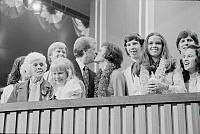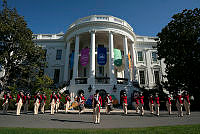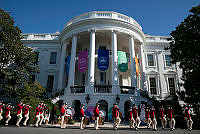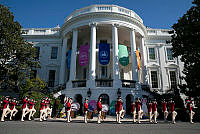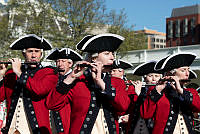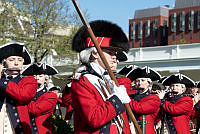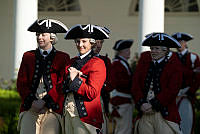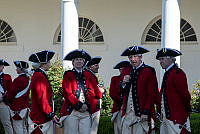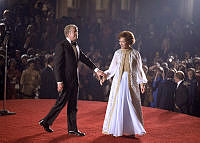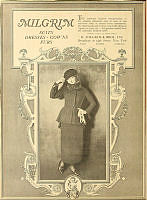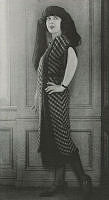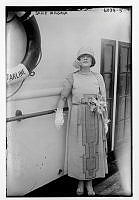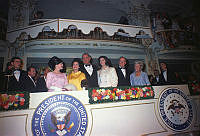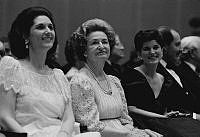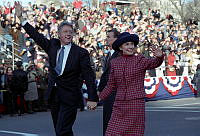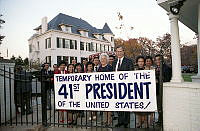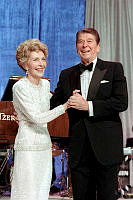Rubenstein Center Scholarship
Inauguration of 1861
Abraham Lincoln Sworn into Office

Inauguration of President Abraham Lincoln, March 4, 1861.
Library of CongressOn December 20, 1860, South Carolina seceded from the United States. Mississippi, Florida, Alabama, Georgia, Louisiana, and Texas followed soon after. In the midst of an unprecedented sectional crisis, President Abraham Lincoln entered office on March 4, 1861, to assume leadership of an anxious and worried nation. The Baltimore Sun commented that the “close of an old and the beginning of a new administration of the affairs of government have always attracted the profound attention of the people of the United States.”1 This inauguration, however, was like no other in American history. The country appeared on the brink of civil war.
Confederate southerners speculated on the message of President-elect Lincoln’s inaugural address. A dispatch published in the Charleston Courier reported, “Lincoln’s Inaugural, it is alleged in public circles, will be pacific, and recommend guarantees to retain the Border States in the Union. This, however, is speculation. We will know better about it tomorrow”2
Elizabeth Keckly, a former slave and soon to be dressmaker and confidant of First Lady Mary Todd Lincoln, recalled the mood of Washington in her 1868 memoir “the streets of the capital were thronged with people, for this was Inauguration day. . .Never was such deep interest felt in the inauguration proceedings as was felt today.”3

The inaugural procession passing the gate outside the Capitol.
Library of CongressLate in the morning, crowds gathered near Willard’s Hotel in hopes of a view of the president-elect.4 Travelers, many hailing from the Northern and Western states, had journeyed to Washington, D.C., for the festivities only to find hotels already booked. Some reportedly wandered about the city the night before, forsaking sleep for the chance to be present at this historic inauguration. The day had started rainy and overcast but by mid-morning the sun began to emerge, accompanied by moderate winds that created noticeable dust clouds in the city.5
Outgoing President James Buchanan met President-elect Lincoln at Willard’s Hotel. They left together via carriage for the traditional ride to the Capitol. Nearly every balcony, rooftop, and window along Pennsylvania Avenue was occupied with Washingtonians and visitors. Onlookers even climbed trees in hopes of a better view.6 Among the organizations taking part in the procession was the Marine Band, a company of U.S. cavalry, and several militia units. The “President’s Mounted Guard” rode close to the presidential carriage. In addition to the military escort, a carriage labeled “Constitution” decorated with red, white, and blue carried two women representing the “Goddess of Liberty” and 34 other women representing each state in the Union. Interestingly, the states that had seceded were still featured in the procession.7
Lincoln delivered his first inaugural address and took the oath of office from the east front of the Capitol. A covering had been placed over the platform to keep the president dry in case of rain.8 Closing his remarks, he addressed the nation as one, remarking, “We are not enemies, but friends. We must not be enemies. Though passion may have strained it must not break our bonds of affection. The mystic chords of memory, stretching from every battlefield and patriot grave to every living heart and hearthstone all over this broad land, will yet swell the chorus of the Union, when again touched, as surely they will be, by the better angels of our nature.” 9

This illustration of office-seekers lining up outside President Lincoln's meeting rooms appeared in Frank Leslie's Illustrated Newspaper on April 6, 1861.
White House Historical AssociationAfter being sworn in, President Lincoln and now former President Buchanan returned to the White House. Many onlookers cheered them as they passed along Pennsylvania Avenue and nearby Lafayette Park.10 Buchanan left the White House shortly after, saying farewell to Lincoln in the Entrance Hall and wishing him the best in the coming administration. President Lincoln proceeded from the Entrance Hall to the Blue Room, accompanied by Lieutenant General Winfield Scott, for an inaugural White House reception.11
The president’s secretary, John Nicolay, had already been busy in Washington preparing for the new administration. His duties included many aspects of formal White House hosting such as creating invitations, seating charts, and menus. Harriet Lane, President Buchanan’s niece and acting First Lady during his administration, fulfilled her duties into the afternoon, planning Lincoln’s inaugural dinner at the White House for family and friends from Illinois.12
Nicolay wrote to his fiancée after the inauguration that “I am fairly installed in the White House.” He described the inauguration as a “fine display” transpiring as “nicely as it could have possibly been devised.” The large presence of military personnel and police discouraged outward displays of pro-Confederate sentiment. However, it was reported that one group of men, “who claimed to be Virginians, made insulting remarks…one of them proposed three cheers for the Southern Confederacy, which he tried by himself, but only got through with one.”13

This sketch by noted Civil War artist and illustrator Alfred Waud depicts the North Front of the White House. On the upper left is an insert of several civilians, as they would have appeared, walking along Pennsylvania Avenue and nearby Lafayette Square.
Library of CongressThe day after the inauguration, the White House was inundated with visitors including a large delegation from Massachusetts. Gathered in the East Room, Lincoln greeted them and spoke of the unity outlined in his inaugural address the previous day.14 While the president was occupied, Lincoln’s two young sons, Tad and Willie, introduced themselves to members of the White House domestic staff.15
Upon settling in at the White House, several of Lincoln’s relatives and associates commented upon the neglect of the building’s interiors. Many furniture items were heavily worn and out of date. Soon after moving in, Mrs. Lincoln initiated plans to refurbish parts of the Executive Mansion. While the state rooms were impressive, other rooms, especially on the Second Floor, were found to be in need of more dedicated upkeep. The cost of refurbishment caused tension between Mrs. Lincoln, and the president, as well as Benjamin B. French, commissioner of public buildings. Newspaper criticism of Mrs. Lincoln’s spending habits would continue throughout the Lincoln administration.16

East Room in the White House, circa 1861, as it appeared during the Abraham Lincoln administration.
White House Collection/White House Historical AssociationDuring the Civil War, the White House served as a powerful symbol of the Union. In its halls and rooms, President Lincoln made numerous important decisions that ultimately secured Union victory. The White House remained the “The People’s House.” Scores of office seekers, military officers, and other visitors maintained a near constant presence inside the Executive Mansion even as the first family navigated the emotionally turbulent atmosphere of a nation at war with itself. Their sadness was heightened with the deaths of Colonels Elmer Ellsworth and Edward Baker, close friends of the Lincolns, as well as the death of the Lincoln’s son, Willie, in 1862.
The Lincoln White House nevertheless enjoyed happy and pleasant times as well. The U.S. Marine Band’s concerts on the South Lawn and in Lafayette Park across the street provided temporary respite. Tad Lincoln’s boyish presence also provided relief, not only for President Lincoln, but also for the soldiers camped around the White House, who grew fond of the lad’s humor and energy. The spirit and drama of the Lincoln White House continues to resonate today through the numerous books written about as well as the popular imagery that abounds of our sixteenth president.













